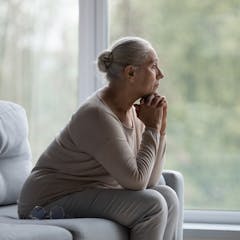
Articles on Aging
Displaying 61 - 80 of 214 articles

I’m happy again: A pandemic-induced move to virtual music theatre presents a paradigm shift for the genre, yet reveals surprising benefits in facilitating new access to music in community.

Many of the world’s most powerful and aspiring leaders are aging or elderly men. That’s a big problem.

Do you know someone who’s had lots of birthdays? That doesn’t always make them old.

Reflection Rooms support people making sense of experiences related to dying and death. They provide an immersive space to read stories written by others and write and share their own stories.

Action is needed to hold off a wave of dementia cases in an aging population. One of the most effective tools to reduce the prevalence of dementia is to address modifiable factors.

The first step is to trust in the friendship and begin to explore how it can be sustained over time.

The protective caps at the ends of chromosomes naturally shorten over time. Researchers found that direct damage can prematurely trigger senescence and contribute to age-related diseases like cancer.

Much dementia research does not reflect ethnically diverse communities. Studies used to make policy, clinical and investment decisions in dementia should reflect the diverse Canadian population.

Three scientists explain the biology and physics of what goes into one of the world’s most grueling races, the Tour de France.

World Elder Abuse Awareness Day highlights the increasing population of older adults around the world and the accompanying rise in elder mistreatment.

When political candidates talk about their long-term care proposals, let’s remember there isn’t much point unless we recruit and adequately compensate enough workers to care for our loved ones.

Ontario voters can bring about change by prioritizing people over profits and casting our ballots for those committed to transforming long-term care into a non-profit model focused on care.

As people age, their eyes lose the ability to focus on close objects. A new eye drop treatment called Vuity can improve vision without the need for glasses, contacts or surgery.

Concerns are growing about Dianne Feinstein’s ability to finish out her Senate term. That won’t dim the accomplishments of her extraordinary career, writes a scholar of San Francisco politics.

Frailty — the physical limitations of seniors living in the community — needs to be assessed before it can be addressed with social and health support. Virtual assessments can speed up this process.

While longer naps are a normal part of aging, excessively long dozes could be a warning signal for cognitive decline.

Older Americans are often taught to be fearful of hackers and scammers in their midst while also being told to investigate potential threats. Better advice is to not engage.

Since canine arthritis can’t be cured, the goal of treatment in dogs is to reduce inflammation to increase comfort and improve a dog’s quality of life.

New research offers insights into the brain after COVID-19 that may have implications for our understanding of long COVID-19 and how the disease affects our senses of taste and smell.

Age is no longer the only definition of midlife. An expert in aging explains why.
